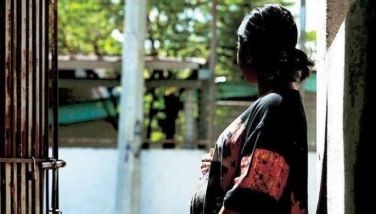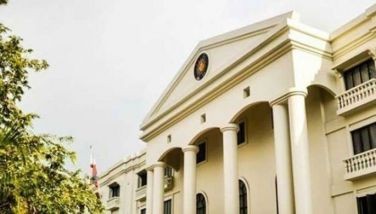Don’t get too close to Mayon, tourists warned
July 20, 2006 | 12:00am
LEGAZPI CITY — The fiery shower of lava from Mayon volcano’s near-perfect cone may be a spectacle but the man who has been guiding local and foreign tourists up the crater since 1953 has advised them to keep their distance.
Seventy-three-year-old Ricardo Dy, a retired employee of the Office of Civil Defense in the Bicol Region and consultant on disaster to Albay Gov. Fernando Gonzalez, cautioned tourists not to venture into the volcano’s six-kilometer permanent danger zone.
"It is best for the tourists to stay in the elevated areas of Legazpi City and Daraga if they want to view the lava oozing out of the volcano," Dy said.
He explained that at the present rate of lava extrusion, an avalanche of house-size boulders and rocks down the steep upper slopes is imminent.
He noted that the Bonga gully, which is about 300 meters wide and 160 meters deep, was filled up with lava very fast.
"Some of the lava and giant boulders are already tumbling out of the Bonga gully and flow at great speed down the volcano," Dy told The STAR.
"If the gullies are already filled up with lava before pyroclastic flows come out, it is very likely that they would find new paths while cascading down the volcano," he added.
Ed Laguerta, resident volcanologist of the Philippine Institute of Volcanology and Seismology (Phivolcs), confirmed that Mayon had already spewed about five million to 10 million cubic meters of lava since Friday.
Dy last climbed the Philippines’ most active volcano in 2002 when he accompanied engineers from the Japan International Cooperation Agency (JICA) in installing lahar sensors and rain gauge devices.
"Despite my old age, they were confident that I could still guide them to trek the volcano through its safe routes," Dy said.
Mayon’s slopes, which Dy had climbed more than 600 times, have an incline ranging from 15 degrees at the lower slopes to 60 to 90 degrees in the upper slopes.
His exploits in climbing Mt. Mayon had been published in several local and international books, newspapers and magazines and featured in video documentaries. He is also noted for giving Phivolcs important inputs drawn from his observations as a veteran climber.
Dy was the one who tipped off volcanologists on the status of the volcano’s lava dome during a climb with Swiss tourists in 1983. Mayon erupted a year later.
He said his very close contact with Mayon’s slopes allowed him to notice lava flow even in the absence of explosions that usually trigger pyroclastic flows.
Phivolcs said the volcano has resumed exhibiting high-level tremors and the flow of lava has now reached three kilometers from the crater, while rocks and burning fragments were falling about four kilometers away.
Light ashfalls were also experienced in areas beyond the permanent danger zone because of prevailing winds.
"At this stage, Mayon continues its mild eruption with little or no explosions. The sulfur dioxide emission rates are also elevated at about 2,157 tons per day, which is expected," Phivolcs said.
Authorities appealed to thousands of farmers and their families yesterday to leave the immediate vicinity of Mayon.
About 7,400 people live inside the permanent danger zone, growing vegetables and rice but the government cannot force them out until a mandatory evacuation is ordered. Many farmers are reluctant to leave their livestock and fields.
"This is our worry… they are tending to their livestock, but when Mayon explodes, the cows are likely to end up roasted," regional disaster relief chief Arnel Capili said.
He said the farmers would be "forcibly removed" from the area if volcanologists determine that an explosive eruption is imminent.
The government of Albay had earlier declared a state of calamity in the cities of Legazpi, Tabaco and Ligao, and the towns of Sto. Domingo, Daraga, Camalig, Guinobatan and Malilipot. The move will enable the local government to quickly release emergency funds.
Gonzalez said provisions in evacuation centers, including comfort rooms, lighting and water facilities, would now be installed in preparation for a possible big eruption.
Early yesterday morning, volcanologists and disaster relief officials flew around Mayon in a helicopter, but the survey was hampered by low clouds that obscured the view of the summit. — With Sheila Crisostomo, Celso Amo, AP, AFP
Seventy-three-year-old Ricardo Dy, a retired employee of the Office of Civil Defense in the Bicol Region and consultant on disaster to Albay Gov. Fernando Gonzalez, cautioned tourists not to venture into the volcano’s six-kilometer permanent danger zone.
"It is best for the tourists to stay in the elevated areas of Legazpi City and Daraga if they want to view the lava oozing out of the volcano," Dy said.
He explained that at the present rate of lava extrusion, an avalanche of house-size boulders and rocks down the steep upper slopes is imminent.
He noted that the Bonga gully, which is about 300 meters wide and 160 meters deep, was filled up with lava very fast.
"Some of the lava and giant boulders are already tumbling out of the Bonga gully and flow at great speed down the volcano," Dy told The STAR.
"If the gullies are already filled up with lava before pyroclastic flows come out, it is very likely that they would find new paths while cascading down the volcano," he added.
Ed Laguerta, resident volcanologist of the Philippine Institute of Volcanology and Seismology (Phivolcs), confirmed that Mayon had already spewed about five million to 10 million cubic meters of lava since Friday.
Dy last climbed the Philippines’ most active volcano in 2002 when he accompanied engineers from the Japan International Cooperation Agency (JICA) in installing lahar sensors and rain gauge devices.
"Despite my old age, they were confident that I could still guide them to trek the volcano through its safe routes," Dy said.
Mayon’s slopes, which Dy had climbed more than 600 times, have an incline ranging from 15 degrees at the lower slopes to 60 to 90 degrees in the upper slopes.
His exploits in climbing Mt. Mayon had been published in several local and international books, newspapers and magazines and featured in video documentaries. He is also noted for giving Phivolcs important inputs drawn from his observations as a veteran climber.
Dy was the one who tipped off volcanologists on the status of the volcano’s lava dome during a climb with Swiss tourists in 1983. Mayon erupted a year later.
He said his very close contact with Mayon’s slopes allowed him to notice lava flow even in the absence of explosions that usually trigger pyroclastic flows.
Light ashfalls were also experienced in areas beyond the permanent danger zone because of prevailing winds.
"At this stage, Mayon continues its mild eruption with little or no explosions. The sulfur dioxide emission rates are also elevated at about 2,157 tons per day, which is expected," Phivolcs said.
Authorities appealed to thousands of farmers and their families yesterday to leave the immediate vicinity of Mayon.
About 7,400 people live inside the permanent danger zone, growing vegetables and rice but the government cannot force them out until a mandatory evacuation is ordered. Many farmers are reluctant to leave their livestock and fields.
"This is our worry… they are tending to their livestock, but when Mayon explodes, the cows are likely to end up roasted," regional disaster relief chief Arnel Capili said.
He said the farmers would be "forcibly removed" from the area if volcanologists determine that an explosive eruption is imminent.
The government of Albay had earlier declared a state of calamity in the cities of Legazpi, Tabaco and Ligao, and the towns of Sto. Domingo, Daraga, Camalig, Guinobatan and Malilipot. The move will enable the local government to quickly release emergency funds.
Gonzalez said provisions in evacuation centers, including comfort rooms, lighting and water facilities, would now be installed in preparation for a possible big eruption.
Early yesterday morning, volcanologists and disaster relief officials flew around Mayon in a helicopter, but the survey was hampered by low clouds that obscured the view of the summit. — With Sheila Crisostomo, Celso Amo, AP, AFP
BrandSpace Articles
<
>
- Latest
- Trending
Trending
Latest
Trending
Latest
Recommended































